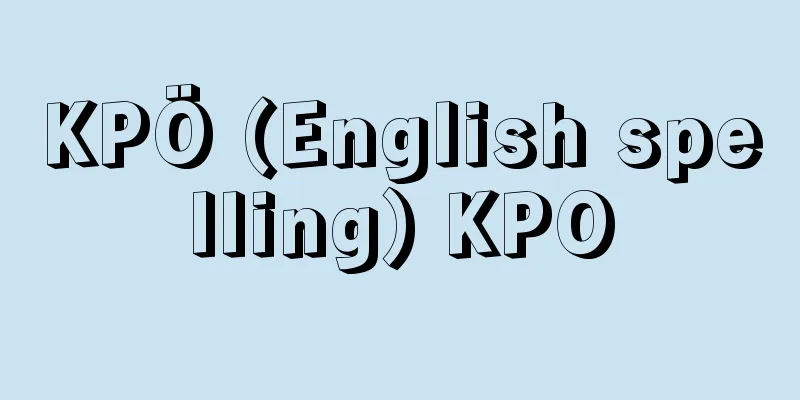Nozzle - Nozuru (English spelling)

|
A thin tube that ejects liquid or gas. It is a device that efficiently converts the potential energy of a fluid into velocity energy and produces a high-speed jet. When ejecting a fluid, the pressure energy is converted into velocity energy by reducing the cross-sectional area of the ejection. This is used in household spray bottles, the oil outlet of pressurized oil stoves, and car carburetors. In water wheels and steam turbines, water or steam is ejected from a nozzle and hits an impeller, which rotates and converts velocity energy into mechanical energy to power the impeller. A nozzle whose flow area perpendicular to the fluid flow becomes smaller as the flow progresses is called a tapered nozzle, and a nozzle whose flow area becomes narrower at one point and then gradually increases beyond that is called a divergent nozzle. A supersonic jet can be produced with a divergent nozzle. The smallest area of a divergent nozzle is called the "throat." When the speed at the throat reaches the speed of sound, the flow rate does not increase any more. The state in which the throat velocity is equal to the speed of sound is called the critical state, and the pressure at which this occurs is called the critical pressure, and the flow velocity, i.e., the speed at which the Mach number is 1, is called the limiting speed. The ratio of the nozzle exit area to the throat area is called the divergence ratio, and when the back pressure is determined by this ratio, the jet will fully expand and become a supersonic jet. [Hidetaro Nakayama] ©Takashi Aoki Cross-sectional shape of the nozzle Source: Shogakukan Encyclopedia Nipponica About Encyclopedia Nipponica Information | Legend |
|
液体や気体を噴出させる細い管。流体のもっているポテンシャル・エネルギーを効率よく速度エネルギーに変換し、高速噴流を得る装置である。流体を噴出させるとき、噴出断面積を小さくすると圧力エネルギーが速度エネルギーに変わることを利用したものである。一般家庭にある霧吹き、加圧式石油こんろの石油出口、自動車の気化器などに使用されている。また水車、蒸気タービンなどでは、水あるいは蒸気をノズルから噴出させて羽根車に当て、これを回転させ速度エネルギーを機械的エネルギーに変換し動力源としている。流体の流れに垂直な流路面積が流れにしたがって小さくなっているノズルを先細(さきぼそ)ノズルといい、途中で一度細くなり、それから先の流路面積がしだいに大きくなっているものを末広ノズルという。末広ノズルでは超音速の噴流が得られる。末広ノズルで最小面積のところを「のど」という。のどのところの速度が音速になると、それ以上流量は増えない。このようにのどの流速が音速に等しい状態を臨界状態といい、その圧力を臨界圧力、流速すなわちマッハ数1の速度を限界速度という。ノズル出口面積とのど部面積との比を末広がり率というが、この率によって定まる背圧のとき完全に膨張し超音速噴流となる。 [中山秀太郎] ©青木 隆"> ノズルの断面形状 出典 小学館 日本大百科全書(ニッポニカ)日本大百科全書(ニッポニカ)について 情報 | 凡例 |
>>: Buzzard (Japanese buzzard)
Recommend
Kompfner, R.
…An ultra-high frequency (UHF or higher) wide-ban...
First verse - Kaminoku
…While we're at it, let's also note how e...
Ahn Kyung-soo
1853-1900 A politician from the Joseon Dynasty. B...
Innovative Kabuki - Kakakushin Kabuki
…Even after the decline of the Onishi Theater, it...
Sargon [II] - Sargon
Neo-Assyrian king (reigned 721-705 BC). Probably t...
Newark - Newark (English spelling)
Newark is the largest city in the state of New Je...
Delilah
…He challenged the Philistines who had gathered a...
Gulf of Lion - Lion (English spelling) Golfe du Lion
A bay in the northwestern Mediterranean Sea of ...
Inviolability of Property Rights - Zaisanken no Fukanshin
The principle that property rights, especially own...
pack
…It is a general term for a group of animals. In ...
Schweizerische Eidgenossenschaft (English notation) Schweizerische Eidgenossenschaft
...Official name: Swiss Confederation Schweizeris...
fly-by-wire
…The technologies applied to CCVs are called acti...
Marine natural science
…The ocean is closer to us than outer space, but ...
Namsa-dang (English spelling)
Korean traveling entertainers. From the mid-Joseon...
Prurigo - prurigo
It refers to an extremely itchy papule (bumps up ...









![Mukaihara [town] - Mukaihara](/upload/images/67ccf9cb25095.webp)